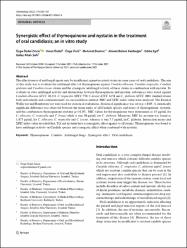| dc.contributor.author | Zincir, Özge Özdal | |
| dc.contributor.author | Özdal, Umut | |
| dc.contributor.author | Ünlü, Özge | |
| dc.contributor.author | Demirci, Mehmet | |
| dc.contributor.author | Katipoğlu, Ahmet Bülent | |
| dc.contributor.author | Egil, Edibe | |
| dc.contributor.author | Şallı, Gülay Altan | |
| dc.date.accessioned | 2022-12-16T10:51:12Z | |
| dc.date.available | 2022-12-16T10:51:12Z | |
| dc.date.issued | 2021 | en_US |
| dc.identifier.citation | Özdal Zincir, Ö., Özdal, U., Ünlü, Ö., Demirci, M., Katiboğlu, A. B., Egil, E., & Altan Şallı, G. (2021). Synergistic effect of thymoquinone and nystatin in the treatment of oral candidiasis; an in vitro study. Odontology, 110(2), pp. 330–337. https://doi.org/10.1007/s10266-021-00667-4
| en_US |
| dc.identifier.issn | 1618-1247 | |
| dc.identifier.issn | 1618-1255 | |
| dc.identifier.uri | WOS: 000707922100001 | |
| dc.identifier.uri | PubMed ID: 34657217 | |
| dc.identifier.uri | https://hdl.handle.net/20.500.12900/127 | |
| dc.description.abstract | The efectiveness of antifungal agents may be insufcient against resistant strains in some cases of oral candidiasis. The aim
of this study was to evaluate the antifungal efect of thymoquinone against Candida albicans, Candida tropicalis, Candida
glabrata and Candida krusei strains and the synergistic antifungal activity of these strains in combination with nystatin. To
evaluate in vitro antifungal activity and interactions between thymoquinone and nystatin, substances were tested against
Candida albicans ATCC 10,231, C. tropicalis ATCC 750, C.krusei ATCC 6258 and C. glabrata ATCC 2001 standard strains
both individually and combinationally via microdilution method. MIC and ΣFIC index value were analysed. The Kruskal
Wallis test and Bonferroni test were used for statistical evaluations. Statistical signifcance was set at p<0.05. A statistically
signifcant diference was observed between the mean ranks of all Candida species and doses of thymoquinone, nystatin,
and the combination thymoquinone-nystatin (p<0.05). MIC values for thymoquinone were determined as 15 μg/mL for
C. albicans, C. tropicalis and C. krusei while it was 30 μg/mL for C. glabrata. Moreover, MIC for nystatin was found as
1.875 μg/mL for C. albicans, C. tropicalis and C. krusei, whereas it was 7.5 μg/mL in C. glabrata. Interaction assays and
ΣFIC index value revealed that, TQ and nystatin have a synergistic efect against to all strains. Thymoquinone was found to
have antifungal activity on Candida species and synergistic efect when combined with nystatin. | en_US |
| dc.language.iso | eng | en_US |
| dc.publisher | Springer Open | en_US |
| dc.relation.isversionof | 10.1007/s10266-021-00667-4 | en_US |
| dc.rights | info:eu-repo/semantics/openAccess | en_US |
| dc.subject | Thymoquinone | en_US |
| dc.subject | Candida | en_US |
| dc.subject | Antifungal drugs | en_US |
| dc.subject | Synergistic efect | en_US |
| dc.subject | Oral candidiasis | en_US |
| dc.title | Synergistic effect of thymoquinone and nystatin in the treatment of oral candidiasis; an in vitro study | en_US |
| dc.type | article | en_US |
| dc.department | İstanbul Atlas Üniversitesi, Diş Hekimliği Fakültesi | en_US |
| dc.authorid | Ahmet Bülent Katipoğlu / 0000-0001-7505-9953 | en_US |
| dc.contributor.institutionauthor | Katipoğlu, Ahmet Bülent | |
| dc.identifier.volume | 110 | en_US |
| dc.identifier.issue | 2 | en_US |
| dc.identifier.startpage | 330 | en_US |
| dc.identifier.endpage | 337 | en_US |
| dc.relation.journal | Odontology | en_US |
| dc.relation.publicationcategory | Makale - Uluslararası Hakemli Dergi - Kurum Öğretim Elemanı | en_US |

















